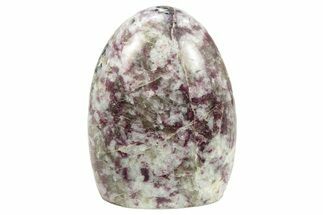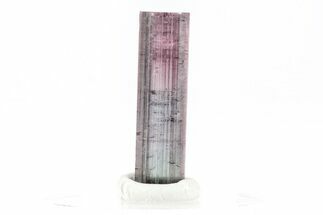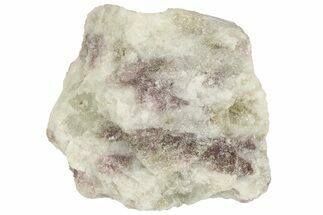This Specimen has been sold.
4.5" Polished Rubellite (Tourmaline) & Quartz Tower - Madagascar
This is a 4.5" tall, hand polished tower made from magenta colored tourmaline (rubellite) in quartz. This rock formation was collected from Madagascar.
Rubellite is a pink-red variety of elbaite, a member of the tourmaline group. Elbaite is a form of tourmaline that is perhaps the most multicolored mineral. It has been discovered in virtually every color of the spectrum and has dramatically increased in popularity since the 1990s. While specimens are commonly faceted into gemstones, most high quality crystals are left as is, or are cut and sold as cross-sectional slices. Elbaite forms as short, stubby, and/or elongated prismatic crystals, often with lengthwise striations. Elbaite aggregations can occur as botryoidal, columnar, radiating crystals and in compact masses.
Elbaite has a wide variety of names, both classic and modern, depending on the colors it presents. They include achroite, a colorless variety; blue cap tourmaline; chrome tourmaline, a green variety caused by chromium impurities; fluor-elbaite; indicolite, a blue variety; Moor's head tourmaline; mushroom tourmaline; Paraiba tourmaline; rubellite, a pink-red variety; siberite, a purple variety; verdelite, a green variety; and watermelon tourmaline, a unique variety with a green exterior and pink to red interior.
The chemical formula of elbaite is Na(Li,Al)3Al6(BO3)3Si6O18(OH)4.
Elbaite has a wide variety of names, both classic and modern, depending on the colors it presents. They include achroite, a colorless variety; blue cap tourmaline; chrome tourmaline, a green variety caused by chromium impurities; fluor-elbaite; indicolite, a blue variety; Moor's head tourmaline; mushroom tourmaline; Paraiba tourmaline; rubellite, a pink-red variety; siberite, a purple variety; verdelite, a green variety; and watermelon tourmaline, a unique variety with a green exterior and pink to red interior.
The chemical formula of elbaite is Na(Li,Al)3Al6(BO3)3Si6O18(OH)4.
About Quartz
Quartz is the name given to silicon dioxide (SiO2) and is the second most abundant mineral in the Earth's crust. Quartz crystals generally grow in silica-rich environments--usually igneous rocks or hydrothermal environments like geothermal waters--at temperatures between 100°C and 450°C, and usually under very high pressure. In either case, crystals will precipitate as temperatures cool, just as ice gradually forms when water freezes. Quartz veins are formed when open fissures are filled with hot water during the closing stages of mountain formation: these veins can be hundreds of millions of years old.
Quartz is the name given to silicon dioxide (SiO2) and is the second most abundant mineral in the Earth's crust. Quartz crystals generally grow in silica-rich environments--usually igneous rocks or hydrothermal environments like geothermal waters--at temperatures between 100°C and 450°C, and usually under very high pressure. In either case, crystals will precipitate as temperatures cool, just as ice gradually forms when water freezes. Quartz veins are formed when open fissures are filled with hot water during the closing stages of mountain formation: these veins can be hundreds of millions of years old.
SPECIES
Tourmaline var. Rubellite & Quartz
LOCATION
Madagascar
SIZE
4.5" tall, 1.8" wide at base
CATEGORY
SUB CATEGORY
ITEM
#245476
 Reviews
Reviews













